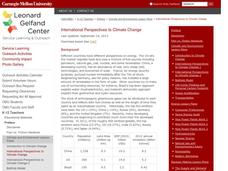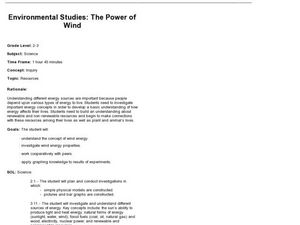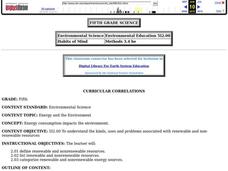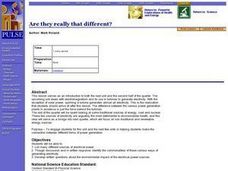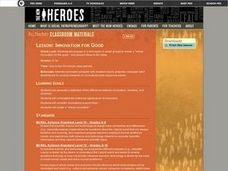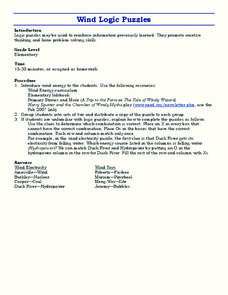Curated OER
Mississippi’s Electricity: From Generation to Consumption
Eighth graders discover how electricity is produced. For this physics lesson, 8th graders infer about the future of Mississippi's energy industry. They participate in a Smart Board interactive activity at the end of the lesson.
Carnegie Mellon University
International Perspectives to Climate Change 1
After a lecture about how the first industrial revolution triggered the path to climate change, your environmental studies class discusses what the impacts are. In a culminating activity, they get into groups and identify countries on a...
Chicago Botanic Garden
Understanding the Greenhouse Effect
Dive into the power of the sun with a two-part lesson. Budding scientists model the greenhouse effect in a hands-on activity, and then participate in a skit that explores the earth's energy balances and what really occurs in the...
Curated OER
Turn On A Light And Do Your Own Revegetation
Students use electricity and plant a seed to observe the process when coal is the major fuel source to produce electricity. They use the packet of native seeds to experiment with revegetation.
Curated OER
Don't Marry the Mole!
Third graders examine the power of solar energy. In groups, they create their own pizza box solar oven to discover the power of the sun and how it is a source for heat and light. To end the instructional activity, they use the internet...
Curated OER
Coal and Oil: Powering Our Way of Life
Students identify and represent some common products that are made using petrochemicals and some of the effects that higher gasoline and coal prices would have on the American economy in a graphical format. They synthesize information...
Curated OER
Environmental Studies: The Power of Wind
Investigate the prospect of wind as a renewable resource. Second and third graders make a pinwheel, answer critical thinking questions, and then attempt to use wind power to wind string. I would be more apt to use this lesson in a 1st or...
Curated OER
Renewable vs. Non-Renewable Resources
Here's a fine lesson plan on renewable and non-renewable sources of energy for your 5th graders. In it, learners list a number of natural resources on the board, then try to sort the resources into appropriate categories. This helps them...
Curated OER
Energy and the Environment
Fifth graders define terms associated with renewable and nonrenewable resources. They identify materials that are renewable and nonrewable. They categorize a list into the correct type of resource.
Curated OER
The Geologists' Dilemma
Students search in groups of five for colored beads that have been scattered over the classroom. They will search for one of our energy resources represented by one color bead to determine that resources are limited.
Curated OER
The Wind & Sun: Powerful Alternatives
Students examine the power that is possible from the sun through an interactive program. They also analyze how energy turns into different forms in different parts of the human body. They finally explore how wind is created and how wind...
Curated OER
Geological Time Line
Students demonstrate knowledge of when coal was formed by plotting a geological time line.
Curated OER
How Green Are We?
Students identify and interpret the importance of energy efficiency in connection with air pollution. They communicate with families and peers about ways to more effectively contribute to the reduction of air pollution. Finally,...
Carnegie Mellon University
Marcellus Shale: Who Pays?
After viewing short clips of unfortunate events, your class will consider two sides of a homeowner's court case, and then learn about the Marcellus shale deposit beneath the state of Pennsylvania and the hydraulic fracturing process. In...
Curated OER
Fossil Fuels-Importance and Formation
Student is introduced to the concept of energy as a common factor among all things. They list three fossil fuels and describe how fossil fuels were formed. They then tell how much plant debris it took to form one foot of coal.
Curated OER
Science: Generating Electricity
Eighth graders examine the various methods of generating electricity and explain their commonalities. They determine what is the most common source of energy and what are the potential environmental health hazards due to electrical...
Curated OER
Mining Reclamation Research Project
Students work together in groups to research a different mining reclamation project. Using the internet, they answer specific questions to the one area they are to focus on. They use the information they gathered to create a PowerPoint...
Curated OER
Conserving Electricity: Turn It Off
Second graders explore causes of air pollution and relate them to energy conservation.
Curated OER
Muffin Mining
Students participate in demonstrations of the problems of mining. They use blueberry muffins to represent their coal deposits.. They make predictions and record their observations. They discuss their results.
Curated OER
Lights, Sounds, Fabrics and Designs: Careers in the World of Design
High schoolers investigate the broad range of jobs that can be found in the world of design. Students explore sound design, language architecture, etc. High schoolers design a resource book and post it on a website for others to share.
Curated OER
Innovation for Good
Many historical innovations were created for the common good. Get your young scholars ready for life as a critical thinker with this lesson which defines the differences between innovation and invention. They will conduct Internet...
Curated OER
GLOBAL WARMING
Students form definitions of the greenhouse effect based on prior knowledge, class discussion, viewing diagrams, and participate in group brainstorming sessions and class discussions related to the impact of the greenhouse effect and...
Curated OER
Wind Logic Puzzles
Students listen to books on wind energy for background knowledge. In this wind logic puzzle, students use knowledge of wind energy and critical thinking skills to complete logic puzzles. Students may work in groups or individually as...
Curated OER
Ethanol
Students explore how to fuel cars with corn and then test different items to explore the process of fermentation.

